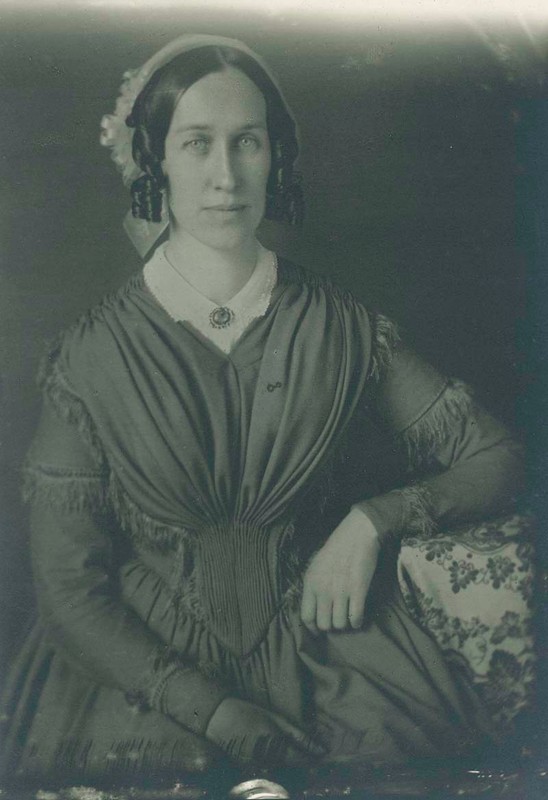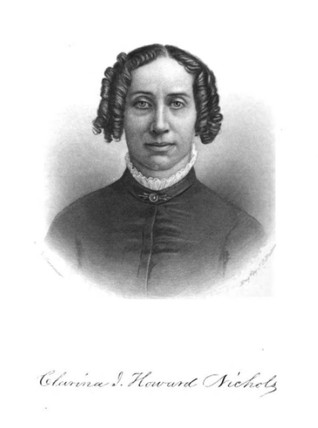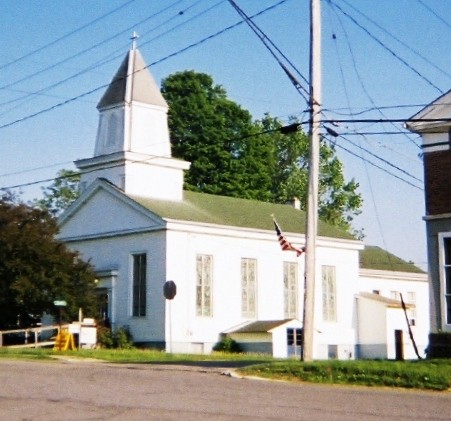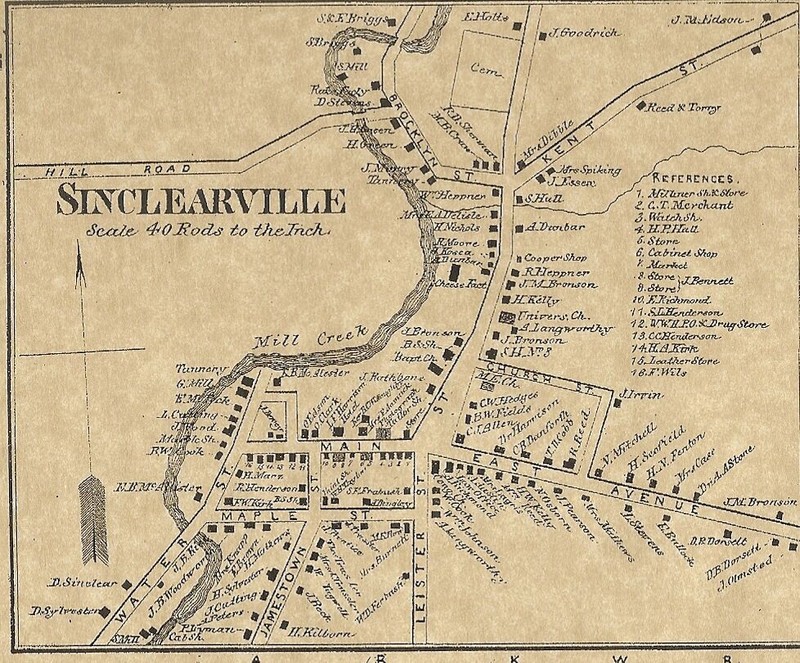Speech by Clarina H. Nichols, c. 1856-1857
Introduction
Text-to-speech Audio
Clarina I. Howard Nichols was a journalist, women's rights suffragist, abolitionist, and reformer who wrote and spoke for many years on issues of women's rights. During the 1850s Nichols was active in campaigning for a free Kansas during the conflict known as "Bleeding Kansas" and she traveled through New York to organize relief efforts for free-state settlers in that state. Her stop at Sinclairville was delayed both by a railroad accident and by the Congregationalist pastor before she spoke about organizing a relief committee here.
Images
Clarina I. Howard Nichols, c. 1855-1860

Engraving of Clarina Nichols, from History of Woman Suffrage, Volume I

In 1856 this was the Congregational Church. Later it became Park United Methodist Church until the congregation outgrew the building and built a new church on Sinclair Drive.

Map of Sinclearville, NY, 1867 with Congregational Church marked.

Map of Sinclairville, NY, 1881, with the location of the Congregational Church (the church later transferred to being a Methodist Church)
.jpg)
Backstory and Context
Text-to-speech Audio
In Chapter 7 of History of Woman Suffrage, Volume I, Clarina I. Howard Nichols recounted an incident at at Sinclairville church:
“In Sinclairville, Chautauqua County, New York, where I arrived late, in consequence of a railroad accident, I found a crowded church. A gentleman introduced to me as ‘Mr. Bull’ was sitting at a table in the extreme front corner of the spacious platform, recording the names and advance payments of a class in music, which, as I had been told outside, was being organized by a gentleman who had arrived with news of my probable detention.
During the next half hour gentlemen rose at three several times and requested Mr. B— to ‘postpone the class business till the close of the lecture: that people had come from a distance to hear the lecture, and were anxious to return home, the night being dark and rainy.’ ‘I will be through soon. I like to finish a thing when I begin.’ ‘There’ll be time enough,” were the several replies, given in a tone and with an emphasis that suggested to my mind a doubt of the speaker’s sympathy with my subject. When the clock pointed to eight, I quietly took my seat in the desk, and was smoothing my page of notes when there fell on my astonished ear—‘I was about to introduce the lady speaker, but she has suddenly disappeared.’ Stepping forward, I said, ‘Excuse me, sir; as the hour is very late I took my pace to be in readiness when you should be through with your class.’ ‘Madam, you will speak on this platform.’ ‘I noticed, sir, that I could not see my audience from the platform, also that the desk was lighted for me.’ ‘Madam, you can’t speak in that pulpit!’ ‘This is very strange. Will you give me your reasons?’ ‘It’s none of your business!’ ‘Indeed, sir, I do not understand it. Will you give me your authority?’ ‘It’s my pulpit, and if you speak in this house to-night you speak from this platform!’ ‘Excuse me, sir; I mistook you for the music-teacher, who, as I was told, was organizing a class in music.’ And stepping quickly to the platform to restore the equanimity of the house, I remarked, as indicating my position, that my self-respect admonished me to be the lady always, no matter how ungentlemanly the treatment I might receive; that the cause of humanity, the cause of suffering Kansas was above all personal considerations, and proceeded with my lecture.
At the close, Mr. B— arose and said: ‘I owe this audience an apology for my ungentlemanly language to Mrs. Nichols. I am aware that I shall get into the public prints, and I wish to set myself right.’ A gentleman in the audience rose and moved, ‘that we excuse the Rev. R. B— for his ungentlemanly language to Mrs. Nichols to-night, on the score of his ignorance.’ The motion was seconded with emphasis by a man of venerable presence. ‘Friends,’ I appealed, ‘this is a personal matter; it gives me no concern. It will affect neither me nor my work. Please name suitable women for the committee of relief which I am here to ask.’ Business being concluded, I turned to Mr. B—, who was shut in with men by a press of sympathizing friends, and expressed my regret, that he should have said anything to place him under the necessity of apologizing, adding, ‘but I hope in the future you will remember the words of Solomon: ‘Greater is he that controlleth his own spirit, than he that taketh a city.’ Good night, sir.’ I learned that a few months before he had prevented his people from inviting Antoinette Brown to speak to them on Temperence, by declaring that ‘he would never set his foot in a pulpit that had been occupied by a woman.’ When three week later I heard of his dismissal from his charge in S—, I could appreciate the remark of his brother clergyman in a neighboring town, to whom I related the incident, that “Brother B— is rather given to hooking with those horns of his, but he’s in hot water now.”
Clarina Howard Nichols (1810-1885) was a journalist and newspaper editor who advocated for women’s marital and economic rights starting in the 1830s and 1840s. Nichols was born in Vermont and lived for a couple of years in New York with her first husband. After divorcing her husband, Nichols returned to Vermont and worked as a newspaper columnist until she married George Nichols, the editor and publisher of the Democrat. She continued writing columns on women’s rights and took over the editorial duties of the newspaper during her husband’s illness.
Nichols was frequent orator on women’s rights and involved in coordinating women’s rights associations and conventions. However, her Sinclairville speech in 1856 was more specifically about events in Kansas, commonly known as “Bleeding Kansas.” Like many women’s rights advocates, Nichols was also an abolitionist. When the Kansas-Nebraska Act passed in 1854, many abolitionists feared that proslavery forces would flood the new state and expand the institution of slavery. To counter this, anti-slavery advocates encouraged free-soilers to move to Kansas so that the state would become a free state with no slavery. Nichols and her family moved to Kansas with the New England Emigrant Aid Company in 1854. After the violence in Kansas escalated in 1856, the National Relief Committee (or National Kansas Committee) was formed in the north to aid and support free-state settlers in Kansas. Clarina Nichols undertook a speaking campaign in New York to raise support and organize relief committees to send money and supplies to Kansas. Nichols’ stop at Sinclairville was part of her efforts to organize these relief committees and speak about Kansas.
After her New York tour, Nichols continued to be an active writer and campaigner for abolition and women’s rights.
The reverend in this story, “Mr. B,” was likely Richard Brockway Bull, a Congregational pastor ordained in Sinclairville in 1855 and who served as acting pastor there between 1854 and 1857. Bull was originally from Connecticut and after his time at Sinclairville he served congregations in Illinois, Minnesota, Iowa, Massachusetts, Wisconsin, Connecticut, Missouri, and Dakota between 1857 and his death in 1888. During the Civil War he served as a chaplain in the 6th Minnesota Volunteer Infantry.
Cite This Entry
Thompson, Kathleen. "Speech by Clarina H. Nichols, c. 1856-1857." Clio: Your Guide to History. October 25, 2021. Accessed March 19, 2025. https://theclio.com/tour/1962/4
Sources
“Chapter VII: Reminiscences By Clarina I. Howard Nichols.” In History of Woman Suffrage, Volume I, 1848-1861. Edited by Elizabeth Cady Stanton, Susan B. Anthony, and Matilda Joslyn Gage, p. 188-189. Rochester, NY: Charles Mann, 1889. Accessed October 21, 2021. https://www.google.com/books/edition/History_of_Woman_Suffrage/vPQLAQAAIAAJ?hl=en&gbpv=0.
“Church Histories, Chautauqua County, NY.” Chautauqua County Gen Web. Accessed October 21, 2021. http://chautauqua.nygenweb.net/CHURCH/Young.htm#Charlotte.
“Clarina H. Nichols.” Iowa State University: Archives of Women’s Political Communication. Accessed October 21, 2021. https://awpc.cattcenter.iastate.edu/directory/clarina-h-nichols/.
Congregational Year-Book, 1889. Issued, under the sanction of the National Council of the Congregational Churches of the United States, By its Publishing Committee, and Containing the General Statistics of those Churches for the Last Previous Year; An Alphabetical List of the Congregational Ministers, and of the Officers and Students of Congregational Theological Seminaries; The Annual Record of Changes; The Vital Statistics of Congregational Ministers Deceased in 1888; Statement of the National Co-Operative Societies; The National and State Organization of Churches; and other miscellaneous information. Boston: Congregational Publishing Society, 1889. Google Books. Accessed October 25, 2021. https://books.google.com/books?id=NAERAAAAIAAJ&pg=PA1#v=onepage&q&f=false.
Gambone, Joseph G, ed. “The Forgotten Feminist of Kansas, 1, The Papers of Clarina I. H. Nichols, 1854-1885.” Kansas Historical Society. Accessed October 21, 2021. https://www.kshs.org/p/the-forgotten-feminist-of-kansas-1/13232.
Minutes of the General Conference of the Congregational Churches of Connecticut at the Eighteenth Annual Meeting at Danbury, November 10-12, 1885, with Reports and Statistics, Volume IV, 1885-1889. Hartford, CT: Press of the Case, Lockwood & Brainard Company, 1886. Google Books. Accessed October 25, 2021. https://books.google.com/books?id=9wM3dSnIK2QC&pg=PA1#v=onepage&q&f=false.
“National Kansas Relief Committee, Minutes.” Kansas Memory. Kansas Historical Society. Accessed October 25, 2021. https://www.kansasmemory.org/item/2416.
“New England Emigrant Aid Company sign.” Kansaspedia. Kansas Historical Society. Accessed October 25, 2021. https://www.kshs.org/kansapedia/new-england-emigrant-aid-company-sign/10231.
“Rev. Obadiah C. Beardsley.” Underground Railroad and Antislavery Activists.” Accessed October 21, 2021. https://orbitist.space/ugrr/content/beardsley-0.
“Sinclairville Church Eyes $2M Building Project.” The Post-Journal. October 2, 2018. Accessed October 21, 2021. https://www.post-journal.com/news/local-news/2018/10/sinclairville-church-eyes-2m-building-project/
"Photograph, Clarina Irene Howard Nichols." Territorial Kansas. Accessed October 25, 2021. https://territorialkansasonline.ku.edu/index.php?SCREEN=show_document&SCREEN_FROM=personalities&document_id=102923&FROM_PAGE=&topic_id=170.
Stanton, Elizabeth Cady, Susan B. Anthony, and Matilda Joslyn Gage, eds. History of Woman Suffrage, In Three Volumes, Volume I, 1848-1861. Rocherster, NY: Charles Mann, 1889. Google Books. Accessed October 25, 2021. https://www.google.com/books/edition/History_of_Woman_Suffrage/vPQLAQAAIAAJ?hl=en&gbpv=1.
“Rev. Obadiah C. Beardsley.” Underground Railroad and Antislavery Activists.” Accessed October 21, 2021. https://orbitist.space/ugrr/content/beardsley-0.
Part of map from WM Stewart, New Topographical Atlas of Chautauqua County New York. Image from Ebay listing: "Charlotte Sinclairville NY 1867 Map with Businesses and Homeowners Names Shown" Accessed October 25, 2021. https://www.ebay.com/itm/291442851223. Full map can be viewed at: "Charlotte Sinclearville New York Antique Map Stewart 1867." Pine Brook Antique Maps. Accessed October 25, 2021. https://www.pinebrookmaps.com/charlotte-sinclearville-new-york-antique-map-stewart-1867/.
"Sinclairville, NY." New York Heritage Digital Collections. Chaut1881 076. Accessed October 25, 2021. https://cdm16694.contentdm.oclc.org/digital/collection/XFM001/id/1587/.

